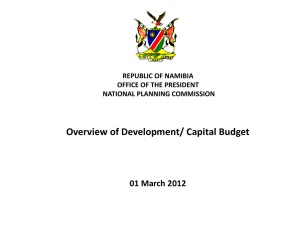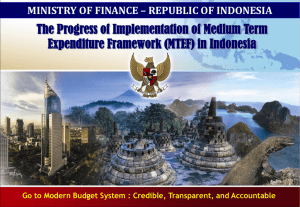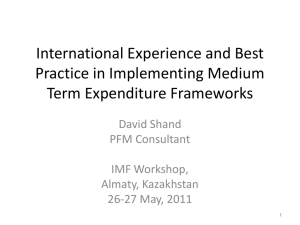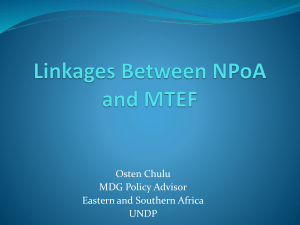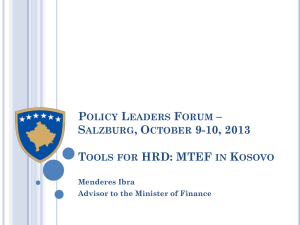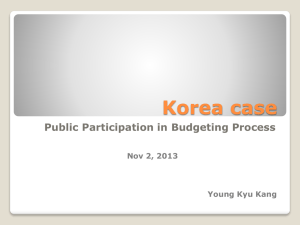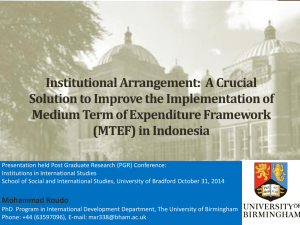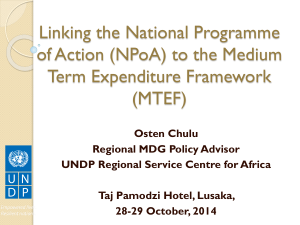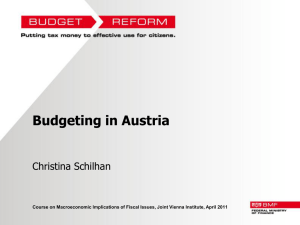Budget cycle and policy based budgeting
advertisement
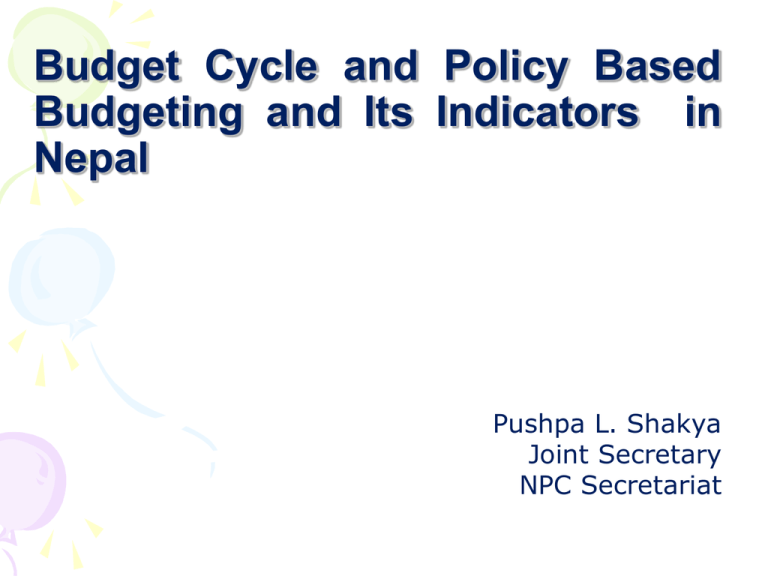
Budget Cycle and Policy Based Budgeting and Its Indicators in Nepal Pushpa L. Shakya Joint Secretary NPC Secretariat Outline of Presentation 1. 2. 3. 4. 5. Introduction Public Financial Management (PFM) Medium Term Expenditure Framework (MTEF) Annual Budgets Linkages Between MDGs, TYP, MTEF and Annual Budget 6. PFM Indicators 7. Issues 8. Way Forward 1. Introduction • Most of the LDCs endowed with limited resources. • They need to use these resources in priority sectors effectively. • Planning system was introduced in the then Soviet Union since 1928. • Adopted and spread after 1940’s in the developing world. • Adopted mixed economy. • Nepal introduced economic plan more than five decades ago. Formulation of macroeconomic framework and policies for the Periodic plan. • GDP Targets • Total investment requirements : public and private • Estimate of required resources • Revenue • Public expenditures • External sources : grants and loan • Domestic borrowings 2. Public Financial Management (PFM) • Public Financial Management (PFM) is very crucial for any government. PFM includes: • sound planning system, • good management of government budget (government revenue, expenditure and debt management, reimbursement), • procurement and accounting, recording, financial reporting and auditing etc. Objective of PFM The main objective of PFM system is : • To improve efficiency in fiscal operations and enhance government accountability and transparency. • To improve control over public expenditure It helps to reduce fiduciary risk and ensure effective utilisation of domestic as well as foreign financial resources . Public Expenditure Management (PEM) • Public expenditure is a crucial instrument in promoting growth, reducing poverty and income inequality, and enhancing human development. • Pro-poor public budget should ensure: - access to public resources, employment opportunities, education, health, safe drinking water and a safe environment to live. . But, Public expenditure backed by insufficient resources and high borrowings can: - bring macro economic instability and high inflation – reduces the purchasing power of the people and erodes competitive advantages PEM is the way in which public resources are allocated and managed in pursuit of: • Fiscal discipline • Strategic allocation of resources consistent with policy priorities • Efficient and effective use of resources Objectives of Public Expenditure Management Improving budgetary outcomes at three levels: 1. Aggregate fiscal discipline, through maintaining a hard budget constraint (through expenditure control) 2. Allocation of resources consistent with policy priorities (strategic allocation) 3. Efficient and effective use of resources -Input -Output -Outcomes 3. Why MTEF? To address the weaknesses in the Public Expenditure Management systems in developing countries the MTEF approach has been developed. • To link annual programs and budget with Medium-Term Plan • To prioritize program and budget according objectives and policies. • To select sectoral programs within the budget ceiling • To ensure allocation of resources for prioritized program. The MTEF Approach • • • The MTEF is a three-year framework of public expenditure within which available domestic as well as foreign resources are allocated between various economic sectors. It can also be described as: A process for matching limited resources with unlimited needs. An integrated system through which all resources (government and donor) are allocated on the basis of policy priorities. • A medium term focus into resource planning, so as to plan ahead for changes in policy and expenditure reallocations. • Enhancing predictability in the flow of resources, nationally, sect orally and at the ministerial/departmental levels. Main objectives of the MTEF Fiscal Discipline: • Fiscal discipline is maintained by developing a consistent Macroeconomic Framework that prescribes a comprehensive and realistic hard budget constraint, within a stable macro economy; . Strategic Allocation of Resources: • development of three year integrated sect oral and/or ministerial allocations cognizant of strategic plans developed by each Sector/Ministry Efficiency and Effectiveness in Resource use: • definition of clear objectives, outputs and costed activities which reflect sectoral/ministerial objectives, and ways of improving efficiency so as to achieve better results with limited resources. MTEF worked as: • Linking annual programs and budget with sectoral and periodic plan • Prioritizing programs along with costing, outputs and expenditures in accordance with the plan’s objectives and targets • Adjusting annual expenditure programs of the Plan to a level consistent with resources availability while maintaining macro economic stability • Ensure resource availability MTEF in Nepal • MTEF initiated in 2002/03 along with the Tenth Plan • Introduce prioritization criteria (regular /current and development/capital) • Unit costing • Performance based budget release system • Able to eliminate or merge more than 200 projects initially • Per project budget increased • Budget for P1 projects increased • Pro-poor and pro-gender budget initiated • Budget deficit contained at desired level • Macroeconomic stability achieved The implementation of the MTEFs has helped the Government to: • maintain fiscal discipline, • prioritize programs/projects within the framework of realistic resources, and • bring them to manageable size with a strategic orientation towards key sectors and activities. The MTEF has in fact become a key instrument for the Government to : • operationalize the Plan by prioritizing the plan/program/project according to the changing resource situation and • strongly linking the annual programs and budget with the plan objectives and strategies. Through the MTEF, government expenditure has been brought within a more realistic budgetary framework: • by prioritizing projects/programs, • by focusing on implementation and monitoring of expenditures, and • by introducing performance-based budget releases. The MTEF has facilitated donors: • to design their assistance strategies and make funding decisions for new projects, as the framework is based on clear vision/mission, objectives, output, activities, with the focus on prioritized areas to attain national objectives. The MTEF has become credible guide to resources planning, programming and monitoring both for the Government and the development partners. Deficiencies in the Formulation of MTEF: • MTEF also needs review and refinement to make it more realistic, credible and successful. • Some deficiencies has been seen in the MTEF process can be spelt out as below: • Delays in the formulation of MTEF on Time • Not legally binding document • Political commitment is important for effective use of MTEF, however it seems lacking. • Not been developed sector specific criteria • Resource gap not properly reflected by the MTEFs. • Budget allocation is not tied up with performance result • Lack of proper monitoring of the performances. Annual Budgets Approval of Programs and Projects • Proposals forwarded to National Planning Commission by LM in a prescribed format (33 points form). • Logical Framework • Project screening criteria • Foreign aid policy • Approved projects are included in the after annual budget for implementation budget discussion. • Annual work plans have to be forwarded to NPC for approval with monitorable indicators. Budgetary Process • District Budget ceiling and guidelines send to the DDCs by NPC– before end of Kartik. • Resource Committee meeting (chaired by VC of NPC)– By last week of Mangsir. • Budget call circulars with budget ceilings, guidelines and format send to LMs by NPC – By Poush second week. • LMs send budget proposal to NPC and MoF- By Chaitra first week. • Program discussion in NPC- Start from Chaitra third week • Budget discussion in MoF- Start from Baishak third week. • Approval of Annual Development Program by NPC chaired by the PM- third week of Ashad. • Approval of the Budget by the Cabinet- Third week of Ashad • Finalisation of budget and presentation in the parliament by Finance Minister – third week of Ashad • Publication of Annual Development Program Part Two by NPC – last week of Ashad. • Approval of annual program by NPC- by second week of Shrawan. Linkage between MDGs, TYP, MTEF and Annual Plan/Programs MTEFs : Business Plans TYP & Implementation Annual Program with Quarterly Breakdown National Human Development Report MDGs New Periodic Plans Problems • Lack of ownership and sustainability • Poor peoples participation • Time overrun / Cost overrun • Lack of proper Quality- at- Entry • Inadequate Supervision Mechanism • Frequent transfer of project staff • Procurement delays / inadequate control • Lack of financial accountability • No proper devolution/ delegation to local self government units. Issues and challenges • Not all stakeholders are involved in project cycle • Policies, annual budget and their implementation are not fully consistent with each other • Non-budgetary expenses are significant and increasing • Programs are not approved on time • Current budget size is in increasing trend. • Dependency on foreign resources is still high. • Over demand of budget than given budget ceiling • Allocation of insufficient budget for projects (mainly in infrastructure related projects). • Continuation of unsustainable and cost ineffective projects. PUBLIC FINANCIAL MANAGEMENT PERFORMANCE INDICATORS Policy- based Budgeting PEFA Indicator 11 : Orderliness and participation it the annual budget process • NPC used to initiate the annual budget-and MTEF formulation process. • Assessment of impacts of the budget on the macro-economic, fiscal and sector policies is required • Active and effective participation by other M/D/As as well as the political leadership in the budget formulation process, • Full participation requires an integrated top-down and bottom-up budgeting process, involving all parties in an orderly and timely manner, in accordance with a pre-determined budget formulation calendar is required. • The calendar should allow for passing of the budget law before the start of the fiscal year as well as for sufficient time for the M/D/As to realistically prepare their detailed budget proposals as per the guidance. • Delays in passing the budget may create uncertainty and delays in some government activities, including major contracts. • Clear guidance should be provided in the budget circular and the budget formulation manual, including budget ceilings for ministries and agencies. • the political leadership should actively involved in the setting of aggregate allocations , particularly for sectors, from an early stage of the budget preparation process. • Budget should be linked with plan,policies and priorities of the government Assessment : • Existence of an adherence to fixed budget calendar. • Clarity/comprehensiveness of political involvement in the guidance of the preparation of budget submissions (budget circular or equivalent). • Timely budget approval by the legislature or similarly mandate body (within the last three years). • Rating PI-11: C+ • A clear annual budget calendar exists but some delays are often experienced in its implementation. The calendar allows M/D/As reasonable time (at least two months from receipt of the budget circular). (B) • A comprehensive and clear budget circular is issued to M/D/As by the NPC, which reflects ceilings approved by the Resource Committee. This approval takes place after the circular distribution to M/D/As but before MDAs have completed their submission. (B) • The budget has been approved with more than two months delay in two of the last three years. (D) Indicator 12 : Multi-year perspective in fiscal planning, expenditure policy and budgeting • Expenditure policy decisions must be aligned with the availability of resources in the medium-term perspective because it has multi-year implications. • Multi-year fiscal forecasts of revenue, expenditure and deficit financing (including reviews of debt sustainability involving both external and domestic debt) must be the foundation for policy changes. • Expenditure policy decisions should be described in sector strategy documents which are fully costed in terms of estimates of forward expenditures to determine whether the new policies are affordable within aggregate fiscal targets. • policy choices should be made and indicative, medium-term sector allocations be established. • Estimation of explicit costing of the implication of new policy initiatives, • clear, strategy linked selection criteria for investments and integrated into the annual budget-formulation process give complete budget policy link. Assessment : • Preparation of multi-year fiscal forecast and functional allocations. • Scope and frequency of debt sustainability analysis (DSA). • Existence of sector strategies with multiyear costing of recurrent and investment expenditure. • Linkages between investment budget and forward expenditure estimates. • Rating PI-12: C+ • Forecasts of fiscal aggregates (on the basis of main categories of economic and functional/sector classifications) are prepared for at least two years on a rolling annual basis. Links between multi-year estimates and subsequent setting of annual budget ceilings are clear and differences are explained. (B) • A DSA for at least for external debt undertaken once during last three years. (C) • Statements of sector strategies exist for major sectors but are only substantially costed for sectors representing up to 25% of primary expenditure or costed strategies cover more sectors but are inconsistent with aggregate fiscal forecasts. (C) • Many investment decisions have weak links to sector strategies and their recurrent cost implications are included in forward budget estimates only in a few (but major) cases. (C ) Government’s Reform Initiatives: • The Government of Nepal has been initiating to improve pubic financial management • Since the Tenth Plan strategic planning documents has been started to produced. • MTEF has been introduced since the Tenth Plan. Similarly, MTBF has been prepared • Treasury Single Account (TSA) has been implemented in 60 districts and under consideration to implement it in additional 15 districts coming days. • Public Expenditure and Financial Accountability (PEFA )initiatives has been taken • Committed for standard accounting system, auditing and timely reporting • Improving overall project management • Project prioritisation criteria were developed for both Current and capital budgets • Ensure multiyear contract • Ensure budget release for P1 projects. • Some progress has been achieved in the area of policy-based budget. • Formulation of Medium Term Expenditure Framework (MTEF) and business plans for some sectors has helped to forecast the budget and its intended results. • However there are some problems in the preparation of MTEF: 1. lack of political commitment on the MTEF and budget preparation; 2. Problem of internalisation and institutionalisation 3. inadequate engagement or understanding of the MTEF among middle and lower-level government officials; 4.uneven linkages between annual budgets and MTEFs; and 5. incomplete sectoral “business plans” (in need of stronger monitoring of outputs). Way Forward For Planning • Plan should be based on more realistic resource forecast. • Formulation of realistic and implementable plan is required. • Ensure inter-sectoral linkages and consistency while formulating plan. • Political commitment should be ensured for effective implementation of plan. • District level planning mechanism should be strengthened. For Budgeting • Ensure political stability • Political commitment on budgetary process and MTEF • Provision of budget announcement day or week in the constitution. • Develop project screening mechanism and sector specific screening approach in the NPC. • Budget allocation has to be made in line with the MTEF priorities. • Internalization/institutionalization of MTEF process should be strengthened. • Detailed trimester work plan for projects/programs should be prepared by implementing agencies to facilitate the tracking of project performance. • Unit cost of outputs and programs/projects of all sectors prepared by the concerned ministries for annual plan and the MTEF has to be updated and revised and use it in the budgeting.. • Capacity building is required. • Need to prioritize the programs and projects before approval and budgeting • Fitting costs within sector ceilings in line with priorities identified. For Implementation and Monitoring • Implementation mechanism need to be strengthened by establishing quality-at-entry committee. • Necessary guidelines pertaining to effective project implementation have to be prepared and strictly followed by the line ministries. • M&E should be strengthened and quality of supervision should be improved. Thank You
